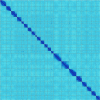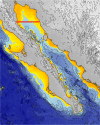Reference genome and demographic history of the most endangered marine mammal, the vaquita
- PMID: 33089966
- PMCID: PMC8247363
- DOI: 10.1111/1755-0998.13284
Reference genome and demographic history of the most endangered marine mammal, the vaquita
Abstract
The vaquita is the most critically endangered marine mammal, with fewer than 19 remaining in the wild. First described in 1958, the vaquita has been in rapid decline for more than 20 years resulting from inadvertent deaths due to the increasing use of large-mesh gillnets. To understand the evolutionary and demographic history of the vaquita, we used combined long-read sequencing and long-range scaffolding methods with long- and short-read RNA sequencing to generate a near error-free annotated reference genome assembly from cell lines derived from a female individual. The genome assembly consists of 99.92% of the assembled sequence contained in 21 nearly gapless chromosome-length autosome scaffolds and the X-chromosome scaffold, with a scaffold N50 of 115 Mb. Genome-wide heterozygosity is the lowest (0.01%) of any mammalian species analysed to date, but heterozygosity is evenly distributed across the chromosomes, consistent with long-term small population size at genetic equilibrium, rather than low diversity resulting from a recent population bottleneck or inbreeding. Historical demography of the vaquita indicates long-term population stability at less than 5,000 (Ne) for over 200,000 years. Together, these analyses indicate that the vaquita genome has had ample opportunity to purge highly deleterious alleles and potentially maintain diversity necessary for population health.
Keywords: Conservation genomics; Phocoena sinus; Vertebrate Genomes Project; genome diversity; historical demography; porpoise.
© 2020 The Authors. Molecular Ecology Resources published by John Wiley & Sons Ltd.
Figures





Similar articles
-
The critically endangered vaquita is not doomed to extinction by inbreeding depression.Science. 2022 May 6;376(6593):635-639. doi: 10.1126/science.abm1742. Epub 2022 May 5. Science. 2022. PMID: 35511971 Free PMC article.
-
Saving the vaquita one bite at a time: The missing role of the shrimp consumer in vaquita conservation.Mar Pollut Bull. 2019 Aug;145:583-586. doi: 10.1016/j.marpolbul.2019.06.043. Epub 2019 Jun 28. Mar Pollut Bull. 2019. PMID: 31590827
-
Genome insights give cause for optimism in the ongoing battle to save the vaquita.Mol Ecol Resour. 2021 May;21(4):1005-1007. doi: 10.1111/1755-0998.13345. Epub 2021 Feb 22. Mol Ecol Resour. 2021. PMID: 33539649
-
Exploring trade-offs between fisheries and conservation of the vaquita porpoise (Phocoena sinus) using an Atlantis ecosystem model.PLoS One. 2012;7(8):e42917. doi: 10.1371/journal.pone.0042917. Epub 2012 Aug 15. PLoS One. 2012. PMID: 22916180 Free PMC article.
-
Harbour Porpoises, Phocoena phocoena, in the Mediterranean Sea and Adjacent Regions: Biogeographic Relicts of the Last Glacial Period.Adv Mar Biol. 2016;75:333-358. doi: 10.1016/bs.amb.2016.08.006. Epub 2016 Sep 28. Adv Mar Biol. 2016. PMID: 27770989 Review.
Cited by
-
Population structure, genomic diversity and demographic history of Komodo dragons inferred from whole-genome sequencing.Mol Ecol. 2021 Dec;30(23):6309-6324. doi: 10.1111/mec.16121. Epub 2021 Aug 30. Mol Ecol. 2021. PMID: 34390519 Free PMC article.
-
Chromosome-level, nanopore-only genome and allele-specific DNA methylation of Pallas's cat, Otocolobus manul.NAR Genom Bioinform. 2023 Apr 4;5(2):lqad033. doi: 10.1093/nargab/lqad033. eCollection 2023 Jun. NAR Genom Bioinform. 2023. PMID: 37025970 Free PMC article.
-
A high-quality genome assembly for a desert-adapted rodent, Merriam's kangaroo rat (Dipodomys merriami).J Hered. 2025 Jul 21;116(4):524-531. doi: 10.1093/jhered/esaf023. J Hered. 2025. PMID: 40243028 Free PMC article.
-
Genetic effects of long-term captive breeding on the endangered pygmy hog.PeerJ. 2021 Oct 8;9:e12212. doi: 10.7717/peerj.12212. eCollection 2021. PeerJ. 2021. PMID: 34707930 Free PMC article.
-
Complete Mitochondrial Genome Analysis Reveals Genetic Diversity in the Narrow-Ridged Finless Porpoise (Neophocaena asiaeorientalis) Across East Asian Waters.Ecol Evol. 2025 Apr 10;15(4):e71229. doi: 10.1002/ece3.71229. eCollection 2025 Apr. Ecol Evol. 2025. PMID: 40225899 Free PMC article.
References
-
- Armstrong, E. E. , Taylor, R. W. , Prost, S. , Blinston, P. , van der Meer, E. , Madzikanda, H. , Mufute, O. , Mandisodza‐Chikerema, R. , Stuelpnagel, J. , Sillero‐Zubiri, C. , & Petrov, D. (2019). Cost‐effective assembly of the African wild dog (Lycaon pictus) genome using linked reads. Gigascience, 8(2), 10.1093/gigascience/giy124 - DOI - PMC - PubMed
MeSH terms
LinkOut - more resources
Full Text Sources
Miscellaneous

